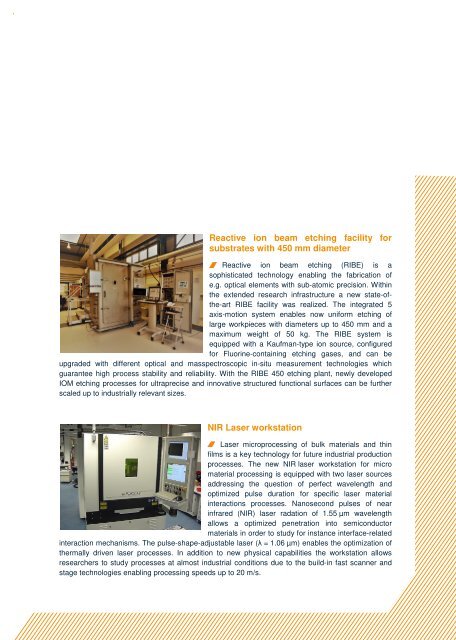Biennial Report 2016/2017
You also want an ePaper? Increase the reach of your titles
YUMPU automatically turns print PDFs into web optimized ePapers that Google loves.
Reactive ion beam etching facility for<br />
substrates with 450 mm diameter<br />
Reactive ion beam etching (RIBE) is a<br />
sophisticated technology enabling the fabrication of<br />
e.g. optical elements with sub-atomic precision. Within<br />
the extended research infrastructure a new state-ofthe-art<br />
RIBE facility was realized. The integrated 5<br />
axis-motion system enables now uniform etching of<br />
large workpieces with diameters up to 450 mm and a<br />
maximum weight of 50 kg. The RIBE system is<br />
equipped with a Kaufman-type ion source, configured<br />
for Fluorine-containing etching gases, and can be<br />
upgraded with different optical and masspectroscopic in-situ measurement technologies which<br />
guarantee high process stability and reliability. With the RIBE 450 etching plant, newly developed<br />
IOM etching processes for ultraprecise and innovative structured functional surfaces can be further<br />
scaled up to industrially relevant sizes.<br />
NIR Laser workstation<br />
Laser microprocessing of bulk materials and thin<br />
films is a key technology for future industrial production<br />
processes. The new NIR laser workstation for micro<br />
material processing is equipped with two laser sources<br />
addressing the question of perfect wavelength and<br />
optimized pulse duration for specific laser material<br />
interactions processes. Nanosecond pulses of near<br />
infrared (NIR) laser radation of 1.55 µm wavelength<br />
allows a optimized penetration into semiconductor<br />
materials in order to study for instance interface-related<br />
interaction mechanisms. The pulse-shape-adjustable laser (λ = 1.06 µm) enables the optimization of<br />
thermally driven laser processes. In addition to new physical capabilities the workstation allows<br />
researchers to study processes at almost industrial conditions due to the build-in fast scanner and<br />
stage technologies enabling processing speeds up to 20 m/s.


